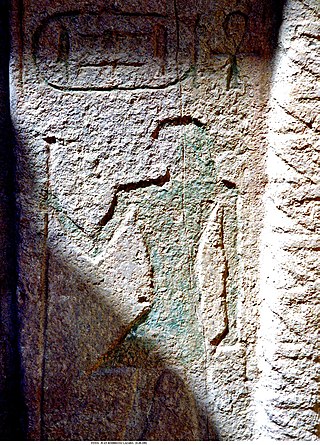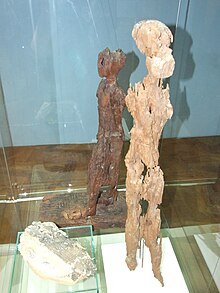
Hor-Aha is considered the second pharaoh of the First Dynasty of Egypt by some Egyptologists, while others consider him the first one and corresponding to Menes. He lived around the 31st century BC and is thought to have had a long reign.

Menkauhor Kaiu was an Ancient Egyptian king of the Old Kingdom period. He was the seventh ruler of the Fifth Dynasty at the end of the 25th century BC or early in the 24th century BC.

Djedkare Isesi was a kng, the eighth and penultimate ruler of the Fifth Dynasty of Egypt in the late 25th century to mid-24th century BC, during the Old Kingdom. Djedkare succeeded Menkauhor Kaiu and was in turn succeeded by Unas. His relationship to both of these kings remain uncertain, although it is often conjectured that Unas was Djedkare's son, owing to the smooth transition between the two.

Neferefre Isi was an ancient Egyptian king of the Fifth Dynasty during the Old Kingdom period. He was most likely the eldest son of king Neferirkare Kakai and queen Khentkaus II. He was known as prince Ranefer before he ascended to the throne.

Nectanebo I was an ancient Egyptian pharaoh, founder of the last native dynasty of Egypt, the 30th.

The Tomb of Perneb is a mastaba-style tomb from ancient Egypt, built during the reigns of Djedkare Isesi and Unas, in the necropolis of Saqqara, north of Pharaoh Djoser's Step Pyramid and about 30 kilometers south of Giza, Egypt. It was the tomb of Perneb, and from the size and placement of the tomb he might have been a court official or royal family member.

The pyramid of Djedkare Isesi is a late 25th to mid 24th century BC pyramid complex built for the Fifth Dynasty pharaoh Djedkare Isesi. The pyramid is referred to as Haram el-Shawaf by locals. It was the first pyramid to be built in South Saqqara.
Nefertkau I was a 4th Dynasty princess of ancient Egypt. She was the eldest daughter of King Sneferu and hence a half-sister to King Khufu. She was the mother of Nefermaat II and the grandmother of Sneferukhaf.
Meresankh IV was an ancient Egyptian queen believed to have lived during the Fifth Dynasty of the Old Kingdom. Her familial ties are the subject of ongoing speculation.
Meret-Isesi was a Princess of Egypt during the 5th Dynasty. Her father was King Djedkare. Meret-Isesi appears as a King's daughterof his body in a relief which likely comes from Abusir.
Hedjetnebu (Hedjetnub; was a Princess of Egypt who lived during the 5th Dynasty. Her father was King Djedkare.

Isesi-ankh was an ancient Egyptian high official during the second half of the Fifth Dynasty, in the late 25th to mid 24th century BC. His name means "Isesi lives". He may have been a son of king Isesi and queen Meresankh IV, although this is debated. Isesi-ankh probably lived during the reign of Djedkare Isesi and that of his successor Unas. He was buried in a mastaba tomb in north Saqqara, now ruined.
Neserkauhor was an Ancient Egyptian prince, son of king Djedkare Isesi, during the second half of Fifth Dynasty. Neserkauhor was buried in Abusir, in an area known today as "Djedkare's family cemetery".

Senedjemib Inti was a vizier from the Fifth Dynasty of Egypt during the reign of king Djedkare Isesi.

Senedjemib Mehi was a vizier from the Fifth Dynasty of Egypt. Senedjemib Mehi started out his career under Djedkare Isesi and eventually became vizier under Unas.

Rashepses was a vizier from the Fifth Dynasty of Egypt. Rashepses was vizier under Djedkare Isesi. A letter directed to Rashepses has been preserved. This decree is inscribed in his tomb in Saqqara. As vizier, he was one of the most important Ancient Egyptian officials. In his tomb, many titles are recorded. It seems that he was first overseer of the scribes of the royal documents, overseer of the two granaries and overseer of all royal works. These are all very important titles, making him an influential official at the royal court. At the final stage of his career he became vizier. The vizier title is only preserved in two letters that are copied on the decoration of the tomb. It seems that most of his tomb was finished and after all that, he was promoted.

Tisethor was a princess of ancient Egypt. She may have been a daughter of Princess Kekheretnebti and granddaughter of the King Djedkare Isesi. Her father is not known. She was a niece of Neserkauhor, Meret-Isesi, and Isesi-ankh.

Ba, also known as Horus Ba, is the serekh-name of an early Egyptian or ancient Egyptian king who may have ruled at the end of the 1st Dynasty, the latter part of 2nd Dynasty or during the 3rd Dynasty. Neither the exact length of his reign nor his chronological position is known.
Kaemtjenent was an ancient Egyptian official under king Djedkare Isesi in the late Fifth Dynasty, during the Old Kingdom period.
Nebunebty was an ancient Egyptian queen consort who has been tentatively associated with the 5th Dynasty of the Old Kingdom. Her name translates as 'the gold of the Two Ladies', or 'golden are the Two Ladies'.













